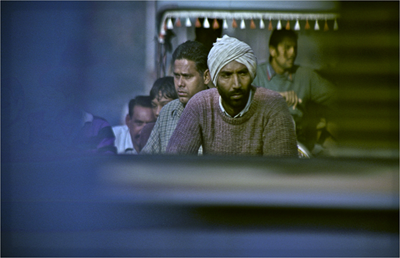Gurvinder is the best horse whisperer
Gurvinder Singh bags the Indian national award for best director for his debut Punjabi film Anhey Ghorhey Da Daan

Gurvinder Singh (right) with actor Mal Singh
Pictures by Sunayana Singh
Sarika Sharma
It was September 2007. A young Film and Television Institute of India graduate was in Chandigarh, and he was still an unknown figure in Punjabi cinema.
“Will you ever make a Punjabi film,” we tossed a question at him. Sitting on the staircase leading to an artist’s house, he was plunged in thoughts. He wasn’t looking us in the eye, as if there was a film was rolling in front of his eyes, in his heart, in his mind.
“I will. But not like the ones made in Punjab.”
The conversation ended there.
Nobody knew that the young man one day will rewrite the script of Punjabi cinema.
Today, as he is bestowed with the National Award for Best Director for his debut film Anhey Ghorhey Da Daan, we know what he was talking about. Never mind, he is still unknown.
Gurvinder was named the best director for his film at the 59th National Awards announced here on Wednesday [6th March 2012]. Gurvinder wouldn’t lie he wasn’t expecting a National Award. “But only for the Best Punjabi Film,” he says.
The film did that get, but, also brought him the Best Director award and his cinematographer Satya Rai Nagpaul, Gurvinder’s junior from Film & Television Institute of India, Pune, the Best Cinematography Award.
We ask him to spare us the cliché, but, would he dedicate the award to someone? “Of course, to my teacher late Mani Kaul, who was also the film’s creative director,” he says.
Gurvinder says the film is a continuation of his legacy and his genre of cinema.
The film is an important landmark in Punjabi cinema. While films like Chann Pardesi (1980), Marhi Da Deeva (1989), and of late, Waris shah — Ishq Daa Waaris (2006) did win the National Award for Best Punjabi Film, this is for the first time a Punjabi film has stood out on the national platform, that too on three fronts.
Gurvinder hopes the film makes people take Punjabi cinema more seriously, and that there is some kind of “re-evaluation” of the cinema, the kind of media content flowing out of Punjab.
He feels that though the films and songs have still kept still, visual arts in Punjab have gone down. “Be it miniature art, pottery, or even Phulkari. We had a rich textile tradition in the state, you know,” he says. He wishes there is “some kind of renaissance… of doing something new”.
And will the film, based on Gurdial Singh’s Punjabi novel of the same name, bring recognition to Punjabi literature too?
“I hope it does. I hope people read the novel. And then people will want to read more of Gurdial Singh and then, maybe, they will pick other Punjabi writers,” he says. “Isn’t that how it happens?” he asks.
Cinema, Gurvinder says, is a cult medium, a documentation of our times. “I know of Iran through Iranian cinema and not through what the newspapers tell me. I know Japan through Japanese cinema and Russia through Russian cinema,” he says.

Samuel John plays the main role of Melu, a rickshaw workers union leader in the film
And cinema’s role goes much beyond entertainment. “It is cultural, social and political history,” he says.
Gurvinder’s next film is also in Punjabi [based on two longish stories by Waryam Singh Sandhu], set against the backdrop of the troubled times of [Khalistani and state terror] militancy in [East] Punjab in the 1980s. He says it is a film about fear and mistrust. •
[Courtesy: Daily Post, Chandigarh